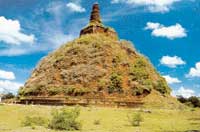| Gaveshaka
delves into the early days of art and architecture in Sri Lanka
Just as much as literature in Sri Lanka grew with Buddhism, so did the country’s art and architecture as well as sculpture - all vital aspects of a country’s heritage. It was after Arahat Mahinda introduced Buddhism during the reign of King Devanampiya Tissa (307-267 BC) that these started developing. In the country’s capital, Anuradhapura, the king built the Maha Vihara, a temple and residence for the monks, after dedicating the Nandana and Mahamega royal pleasure gardens to the Maha Sangha. The earliest monument found in Sri Lanka is the ‘stupa’, which is described as a hemispherical dome surmounted with a spire (‘kota’). During the time of Emperor Asoka, numerous ‘stupas’ were built at hallowed sites in India. In these were enshrined relics of the Buddha which people venerated. When it was observed that there were no Buddha relics in Sri Lanka, the king, on Arahat Mahinda’s suggestion, appealed to Emperor Asoka to send some relics. He responded to the king’s request and sent the right collarbone relic of the Buddha. The king built the Thuparama dagaba to enshrine this relic. This was thus the oldest stupa built in Sri Lanka. Originally it was in the shape of a heap of paddy but as restorations were done in later years, it took the form as seen today. It has a diametre of 59 feet 6 inches at the base. As the name suggests, Thuparama comprised a ‘stupa’ and an ‘arama’, a residential complex. Ruins of such a complex can be seen within an area of over three acres around the ‘stupa’. The ‘stupas’ built later on were much larger than the Thuparama. King Dutugemunu (161-137 BC) built the Mirisaveti which ha a diametre of 168 feet at the base and the most venerated ‘stupa’ - Ruvanvali Mahaseya, also known as Ratnamali Mahathupa. While the base has a diametre of 289 feet, the height is given as 120 cubits (‘riyan’), equivalent to around 300 feet. It took the form of ‘bubbulakara’ or bubble shape.
Large stupas
were also built at Mihintale at the site where Arahat Mahinda met
the king, Magama, Dighavapi (near Ampara), Kataragama and other
places. The builders of ‘stupas’ in Sri Lanka had closely
followed the designs of such monuments built in Sanchi and other
places in India. In huge monuments, the dome rose from a triple-based
platform. The dome was surmounted by a square railing of wood or
stone which later became a cube of masonry. A stone pillar embedded
in the dome rose above the railing. The ‘stupa’ was
crowned by an umbrella (‘chattra’) or a series of umbrellas.
|
||||
Copyright © 2001 Wijeya Newspapers
Ltd. All rights reserved. |
